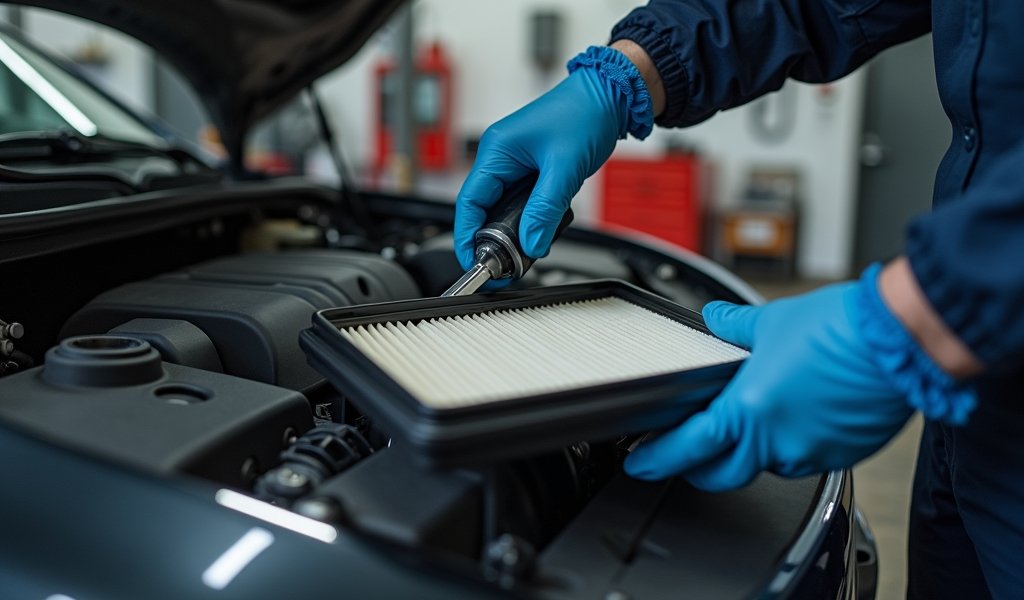Overview
This article provides seven professional tips for properly maintaining and replacing breather element filters in equipment, emphasizing their critical role in preventing contaminants from entering hydraulic systems and engines during air exchange. The guide covers replacement schedules, necessary tools, shutdown procedures, removal techniques, installation best practices, post-installation checks, and the severe consequences of neglecting this maintenance task, which can lead to expensive equipment failures.
Table of Contents
- Why Breather Elements Matter
- Understanding Your Filter Replacement Schedule
- Gathering the Right Tools
- Proper Shutdown Procedures
- Correct Removal Techniques
- Installation Best Practices
- Post-Installation Checks
- Conclusion
- Frequently Asked Questions
Why Breather Elements Matter
Ever wonder why your equipment needs to “breathe”? Just like you, your machinery needs to exchange air during operation. As fluid levels rise and fall in your hydraulic systems or engine crankcase, air moves in and out—and that’s where breather element filters come into play.
These unsung heroes prevent dust, moisture, and airborne contaminants from entering your system during this “breathing” process. Think of them as the bouncers at an exclusive club, allowing clean air in while keeping troublemakers out.
I’ve seen firsthand how a neglected breather element can lead to catastrophic equipment failure. When contaminants slip past this first line of defense, they cause accelerated wear on moving parts, degradation of hydraulic fluid, and ultimately, expensive repairs that could have been easily prevented.
The breather element filter works alongside your positive crankcase ventilation system to maintain the delicate balance of pressure and cleanliness that your equipment needs to function properly.
Let me share seven professional tips that will help you master the art of breather element filter changes and keep your equipment running smoothly for years to come.
Understanding Your Filter Replacement Schedule
One size doesn’t fit all when it comes to filter replacement intervals. While your manufacturer’s service manual provides baseline recommendations, your specific operating conditions should dictate your actual schedule.
Do you work in dusty environments? You’ll likely need more frequent changes. Operating in extreme temperatures or high humidity? Same story. Heavy equipment usage calls for vigilance, as these conditions accelerate contamination.
According to a study by Machinery Lubrication, up to 70% of hydraulic system failures can be traced back to fluid contamination—much of which enters through inadequate breather filtration.
Watch for these warning signs that scream “replace me now”:
- Visible dirt accumulation around the breather cap
- Unusual noises during operation
- Decreased system efficiency or sluggish performance
- Discolored hydraulic fluid
- Evidence of moisture in the system
I recommend creating a maintenance calendar based on your equipment’s operating conditions rather than relying solely on hours of operation. This proactive approach can save you thousands in repair costs down the line.

Gathering the Right Tools
Before diving into your breather element replacement, gather everything you’ll need. Nothing’s more frustrating than being elbow-deep in a job only to realize you’re missing a critical tool.
Here’s what you’ll need:
- The correct replacement filter (verify part numbers before starting)
- Filter wrench or strap wrench sized appropriately
- Clean rags or lint-free cloths
- Container for the old filter
- Thread lubricant (if recommended)
- Torque wrench (if specified)
Don’t forget about safety gear! At minimum, you’ll want:
- Protective gloves (nitrile works well)
- Safety glasses
- Clean work clothes that won’t leave fibers behind
I’ve seen technicians improvise with the wrong tools too many times, resulting in damaged housings, cross-threaded fittings, or worse. The right tools make for a smooth job and protect both you and your equipment.
Pro tip: Take a quick photo of the filter orientation before removal. This simple step has saved me countless headaches when installing the new element correctly.
Proper Shutdown Procedures
Safety first, folks! Proper shutdown isn’t just about flipping a switch—it’s about protecting yourself and your equipment.
Follow these steps before touching that filter:
- Turn off the equipment completely and disconnect power sources
- Allow the system to cool if it’s been running (hot oil can cause serious burns)
- Relieve system pressure according to your manufacturer’s guidelines
- Place “do not operate” tags if you’re in a shared workspace
I once had a client skip the pressure relief step, and let me tell you—oil under pressure finds exit routes you never knew existed! Not only was it a safety hazard, but it created a contamination nightmare.
Next, prepare your workspace to prevent introducing new contaminants:
- Clean the area around the breather element
- Cover nearby openings in the system
- Position a catch basin for any fluid drips
- Ensure good lighting so you can see what you’re doing
Remember, contaminants introduced during maintenance can be just as harmful as those the filter is designed to catch. Even microscopic particles can cause gradual wear over time, so cleanliness is critical.
Correct Removal Techniques
Now we’re getting to the hands-on part! Removing the old filter requires care rather than brute force.
Start by identifying the exact location of your breather element—typically at the highest point of fluid reservoirs or along the top of your equipment. Then follow these steps:
- Clean the exterior housing thoroughly to prevent dirt from falling in
- Use your filter wrench to break the initial tension (counter-clockwise in most cases)
- Switch to hand-turning once loosened
- Remove the housing carefully, keeping it upright to prevent spills
- Extract the filter element, noting its orientation
Dealing with a stubborn filter? Don’t force it! Apply a penetrating lubricant to the threads and wait 15 minutes. If it’s still stuck, check your service manual for specific removal instructions.
Before tossing that old filter, take a moment to inspect it—it’s telling you a story about your equipment’s health:
- Excessive dirt means you may need more frequent changes
- Metal particles could indicate internal component wear
- Moisture suggests possible seal failures
- Discoloration might point to overheating issues
This “filter forensics” can help you spot potential problems before they become expensive failures. Many times, I’ve identified developing issues just by paying attention to what the old filter was telling me.

Installation Best Practices
Installing the new breather element properly is just as important as removing the old one correctly. Let’s make sure your system can breathe easy with these best practices.
First, compare your new filter to the old one. They should match in size, shape, and specifications. I’ve seen enough mismatched filters to know that “close enough” rarely is.
Handle the new filter with clean hands or gloves, touching only the outer edges. The filtration media is delicate, and oils from your skin can compromise its effectiveness.
Many operators don’t realize that an oil catch can works alongside your breather element to create a comprehensive contamination control system, especially in modified vehicles.
Follow these installation steps:
- If recommended, pre-lubricate the gasket with clean system fluid
- Orient the filter exactly as the old one was positioned
- Start threading by hand to avoid cross-threading
- Once hand-tight, use your torque wrench to achieve the manufacturer’s specified torque
Avoid these common mistakes that I see even experienced technicians make:
- Double-gasketing (when the old gasket sticks to the housing and you add a new one)
- Contaminating the new filter by placing it on dirty surfaces
- Using the wrong lubricant on gaskets
- Over-tightening (which can damage the housing or create leaks)
Remember, precision during installation pays dividends in system performance. According to Hydraulics & Pneumatics, a properly seated breather element creates the perfect seal, ensuring all air entering your system passes through the filtration media rather than bypassing it.
Post-Installation Checks
Your job isn’t done when the new filter is installed! Post-installation checks are your quality control process.
Start with a visual inspection for proper seating and alignment. Make sure everything looks right before moving forward.
Next, ensure all tools and materials are removed from the work area. You’d be surprised how often loose rags or tools get left behind, only to cause problems later.
Follow your normal startup procedures and be on the lookout for:
- Unusual noises that might indicate air leaks
- Proper pressure readings across your system
- Any signs of leakage around the breather element
- Normal operation parameters
I recommend keeping a close eye on things for the first few hours of operation. This break-in period often reveals issues that weren’t immediately apparent.
Finally, don’t forget to document your maintenance! Record:
- The date of replacement
- Observations about the old filter’s condition
- The specific replacement part number used
- When the next change should be scheduled
This documentation creates a valuable maintenance history that helps you optimize your maintenance schedule over time. I keep digital records for all my clients, which has proven invaluable for predicting and preventing issues before they cause downtime.
Conclusion
Changing a breather element filter might seem like a small task, but it’s one of those maintenance fundamentals that separates equipment that consistently performs from equipment that consistently fails. By following these seven professional tips, you’re not just changing a filter—you’re protecting your investment and preventing a chain reaction of potential problems.
Remember that proper breather element maintenance has a compound effect: each correctly performed change prevents contamination throughout your system, protecting expensive components like hydraulic pumps, seals, and valves.
I’ve seen too many operators learn this lesson the hard way, stretching their maintenance intervals to save a few dollars only to face repair bills in the thousands. Don’t be one of them!
The next time your breather element needs changing, approach it with the same care and attention you’d give to any other critical maintenance task. Your equipment (and your wallet) will thank you for it.
Do you have any questions about breather element maintenance or other equipment care tips? Drop them in the comments below—I’m always happy to help fellow gearheads keep their machinery running smoothly!
Frequently Asked Questions
How often should I change my breather element filter?
Follow your manufacturer’s recommendations as a baseline, but adjust based on your operating conditions. Dusty environments, extreme temperatures, or heavy usage all call for more frequent changes.
Can I clean and reuse my breather element instead of replacing it?
Most breather elements are not designed to be cleaned and reused. Attempting to clean them can damage the filter media and compromise their effectiveness.
What happens if I don’t change my breather element filter?
A clogged breather can cause pressure buildup in your system, leading to blown seals or forced air intake through unfiltered paths. This introduces contaminants that accelerate wear on internal components.
Do I need special tools to change a breather element filter?
Basic hand tools are usually sufficient, with a filter wrench or strap wrench being the most specialized tool required. Always check your service manual for any equipment-specific requirements.
Can a bad breather element affect my engine’s performance?
Absolutely—a compromised breather element can lead to pressure imbalances, oil contamination, and even oil consumption issues. These problems can reduce power output and efficiency over time.

